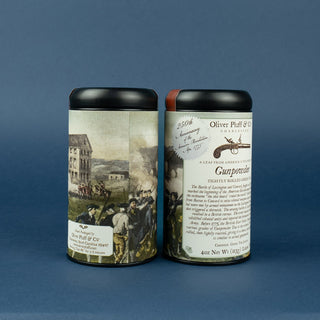This month is the 250th anniversary of the battle of Lexington and Concord. You can find our tin of tea commemorating the battle here.
Dear Oliver,
April is an important month in the birth of the United States. Just over two
years after the Boston Tea Party, locals continued to fight for freedom from
the tyranny they felt from England.
“…the 250th Celebration of the “shot heard 'round the world” — a phrase
long associated with the Battles of Lexington and Concord. April 19, 1775,
now commemorated as Patriots' Day, marked the beginning of the battles
of the American Revolutionary War. On that day, starting in Boston, the
Sons of Liberty arranged for a signal to be shown in the tallest church
steeple in Boston to inform Concord of the army’s route of march. Two
lanterns are seen in the in the Old North Church steeple signifying the
regulars will be coming across Boston Harbor (“one if by land, two if by
sea”). As Paul Revere and William Dawes rode through the surrounding
towns, others set out to join in the alarms along with church bells ringing
and warning shots fired. Minutemen assembled on town greens along with
other militia companies, and by the time the regulars crossed Boston
Harbor to Lechmere Point, word of their mission had already reached
Concord,” america250sar.org.

During this time, the tea boycott was in full swing. Because they couldn’t
pay hefty prices for tea, New Englanders of the time found themselves
without their favorite hot beverage.
So, according to the Boston Tea Party Ships & Museum, Americans turned
to a variety of native flora. “So-called ‘Liberty Teas’ were made with a
homegrown bounty of various herbs, flowers, fruits, mints, seeds, and tree
barks,” thedailymeal.
“The move towards Liberty Tea was not just a boycott but also a testament
to the colonists’ resourcefulness and self-sufficiency,” reports teaasks.com.
“They gathered local herbs and plants such as raspberry leaves, mint, and
goldenrod to create flavorful and medicinal teas. These ingredients were
not only readily available but also had historical significance and medicinal
properties. For example, mint was known for its soothing effects on
digestion, and raspberry leaves were used for their nutritional benefits. By
utilizing these local resources, the colonists supported the war effort and
reduced dependence on British imports.”
States often had local offerings that have survived to this day including
goldenrod from Delaware, Yeepann from North Carolina, and wintergreen
from Maine.
Some sources proclaim that the role women played to make “Liberty Teas,”
by gathering and growing the alternate ingredients and then creating the
subsequent brew, was essential to the success of the tea boycott.
Other popular colonial flavors included: spearmint, peppermint, orange
bergamot, catnip, pennyroyal, raspberry leaves, strawberry leaves, lemon
balm, and verbena.
As the boycott stretched on blends arose, blossoms of linden, elder, red
clover, chamomile, and violet offered colorful brews. Colonists
experimented with tree bark such as sassafras and willow. Colorful dried
strawberries, blueberries or apples, made delicious options. And, fennel,
dill, parsley, thyme, marjoram, rosemary, sage, sweet fern, spicebush, and
ambrosia were borrowed from the spice cabinet.

Truly the options were endless as colonists aimed to keep their rituals and
traditions going as a decade of war engulfed the nation. Of note, coffee
gained popularity during this time.
However, tea consumption quickly returned with the close of the war in
1783. George Washington is said to have taken his tea both morning and
night. Merchants in the colonies raced to fill the void and immediately set
up trade routes with China to supply the popular leaves.
So, with the “Shot Heard Round the World” colonists proved their mettle
and created their “Liberty Teas” while they waited for victory.

